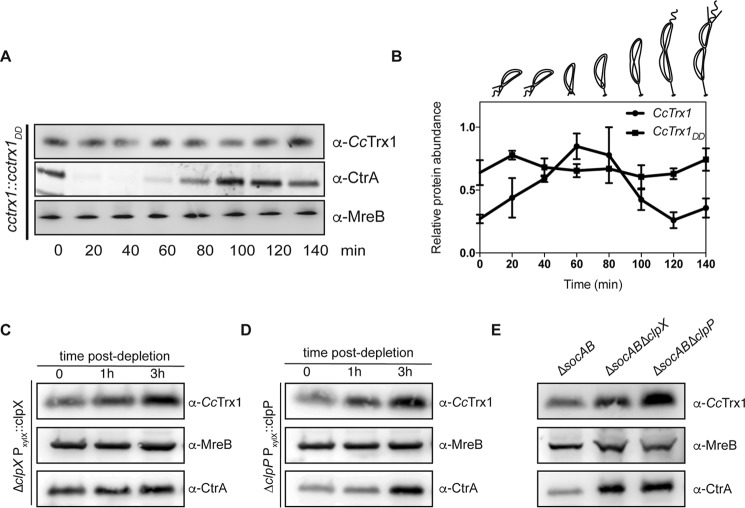Figure 5.
CcTrx1 is degraded by the ClpXP machinery. A, in the cctrx1::cctrx1DD strain, the levels of CcTrx1 do not fluctuate over the cell cycle. A culture was synchronized, and samples were withdrawn every 20 min. Immunoblotting detection shows the levels of CcTrx1 over the cell cycle. MreB is used as a loading control, and CtrA serves as a synchrony control. This experiment was performed in triplicate, and this panel shows representative results. The additional experiments are present in Fig. S3. B, quantification of the levels of CcTrx1. Bands were detected by immunoblotting and quantified using ImageJ. This graph shows the mean of three independent experiments. Error bars represent S.E. C, CcTrx1 accumulates in a ClpX depletion strain. ΔclpX xylX::Pxyl-clpX cells were grown under permissive conditions before xylose was washed out to start the ClpX depletion. Samples were withdrawn after 1, 2, and 3 h. CcTrx1 was detected by immunoblotting. MreB serves as a loading control, and CtrA is a known substrate of ClpXP. This experiment was performed in triplicate, and this panel shows representative results. D, CcTrx1 accumulates in a ClpP depletion strain. ΔclpP xylX::Pxyl-clpP cells were grown under permissive conditions before xylose was washed out to start the ClpP depletion. Samples were withdrawn after 1, 2, and 3 h. CcTrx1 was detected by immunoblotting. MreB serves as a loading control, and CtrA is a known substrate of ClpXP. This experiment was performed in triplicate, and this panel shows representative results. E, CcTrx1 accumulates in the absence of ClpX or ClpP. The CB15N ΔsocAB, CB15N ΔsocAB ΔclpX, and CB15N ΔsocAB ΔclpP mutants were grown until A660 nm reached 0.3. CcTrx1 levels were assessed by immunoblotting. MreB serves as a loading control, and CtrA is a known substrate of ClpXP. This experiment was performed in triplicate, and this panel shows representative results.

